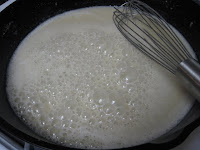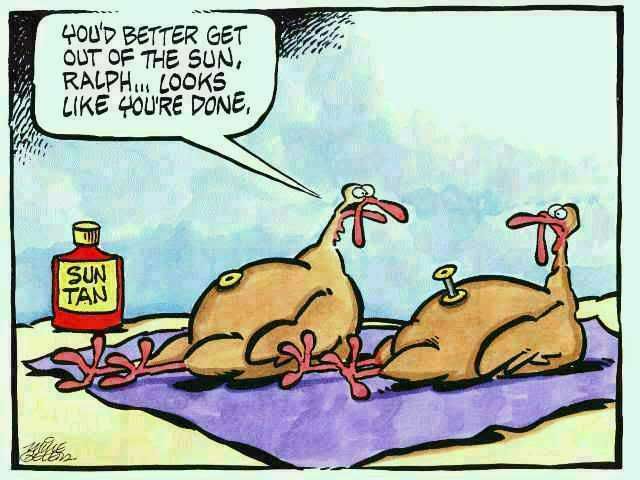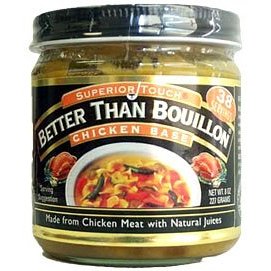Susan from Texas inspired this post.
Do you like brisket? I don't mean your Bubbie Irma's brisket with gravy, braised with onions and served on Yom Kippur and Rosh Hashanah, I mean the Texas-styled stuff, smoked for hours until it's falling-apart tender and has a nice, borderline-burned "bark" or crust? Ever wanted to smoke your own but didn't know how to go about it? Don't want to buy a smoker? Worried that it will fail? You've read all the BBQ sites on the Interwebs and you're paralyzed with fear? Fear not, my peeps. I'm gonna make it simple for you. The Interwebs sites dedicated to BBQ are detailed - too detailed, but you can always consult them if you feel like you need more information.
But it's November, right? If you live in a relatively mild part of the country you can still do brisket, even here in Oregon. It might be a problem some place in the Rockies where it's already snowing, but it can still be done. Or you can wait for next spring. Your call.
A lot of what I'm going to say mirrors what you can learn elsewhere, especially at the website that Weber hosts. There's nothing especially inventive about my method for smoking a brisket except that it involves not only smoke, but an oven. That's the part that makes it practically foolproof, so let's get started. It takes close to an hour and a half for every pound to cook a brisket, and I assure you there will be no sleep lost. That's where the oven comes in, but you're still going to need to plan ahead.
What will you need? Well, you'll need a Weber kettle, preferably the 22 1/2 inch model. You could buy a Weber Smokey Mountain cooker, but that will set you back about $350 and it comes with its own directions, so you wouldn't need me. People swear by them, but they're not necessary. Ditto a thing called the Big Green Egg, but that will set you back the better part of a thousand bucks - money you could spend on wine - so we'll ignore it. I've heard of people smoking on gas grills and that worked for me once, too, but it's a bit trickier. Let's stick with the Weber, which many people have.
In the way of equipment, you'll need a
cheap oven thermometer. I say cheap because it's going to get filthy in the smoke, so there's no reason to buy one that costs more than about $4. You'll also want a remote thermometer you can program to sound an alarm when the desired temperature is reached within the meat. I think one of these is a kitchen requirement, but you might have to buy one and there's conveniently one listed in the "my favorites" banner from Amazon. It's a
Polder.
Beyond that, you'll need salt, pepper, granulated garlic or garlic powder and onion powder. Perhaps some paprika. And you'll need a brisket. This is where it gets a little tricky. You need a WHOLE brisket, with the point cut and the flat cut intact. They're called packer cuts, they generally come shrink-wrapped in cryovac (a heavy plastic) and they're becoming easier to find. If what you're thinking of buying doesn't weight at least ten pounds, it's not a packer cut.

This is one I bought last spring. You'll note how thick it is and how heavy the fat covering is. I tried to find a better pic on the Web but couldn't find a good example that shows the point (or "deckle") and the flat. Many "experts" will tell you to buy only USDA Choice or Prime briskets, but I have it on good authority that the big time BBQ folks in Texas don't bother. It's a fatty cut anyway, so I'm not sure it makes any difference what grade it is.
I get mine at a place called "Cash and Carry", which supplies foodstuffs to restaurants - 50-pound bags of rice and 5-pound blocks of cream cheese, for example - and I've never paid more than $1.79 per pound, which makes this a very economical meal. C&C is located in several Western states, but there's likely a similar store near you. Otherwise, ask your butcher or supermarket meat manager if he can order a packer for you.
First you have to trim your beast. Make sure your knife is sharp, but this is about the most difficult part of the process, so everything from here is downhill. You'll want to take off all but about 1/4" of the fat and some of the extra fat in the seam between the two parts of the meat.
This is what mine looked like (note the big pile of trimmings) after it was trimmed and seasoned. I wish I'd gotten a shot of its underside, but I didn't. Sorry.
Season liberally with salt (use Kosher salt - I don't even have table salt except for baking), pepper, granulated garlic and onion powder. You can add some paprika and/or cayenne if you like, but I don't bother on the theory that simpler is better. Rub the seasonings into the meat aggressively and let the beast sit for a while and build a fire.
Use about 12-15 charcoal briquets or an equal amount of lump charcoal. It's surprising how little charcoal it takes to maintain the low temperature you're looking for. Build your fire against one side of the kettle so you can put the meat away from it on the other side and add a disposable aluminum pan of hot water on the fire grate below where the meat is going to go. When the charcoal is ashed-over, add the cooking grate (which you've cleaned, right?) and put your oven thermometer on the grate as far from the fire as you can get it. Add the lid, leaving the lower vents fully open and the top vents about half way closed. Go away for about 10 minutes while the fire stabilizes itself.
Go back and check the temperature on your thermometer. It should be between 200 and 250 degrees. If it's higher than that, close the top vents a bit and check again in 10 minutes. When the fire is the right temperature, add a big handful hickory/alder/apple/cherry/oak chips you've soaked in water for at least an hour, and replace the lid. Don't use mesquite for either the smoking chips or the charcoal. It's too strong. When the chips begin to smoke, add the brisket fat side up as far away from the fire as you can, and go away for about a half hour.
When your half hour is up, add about six more pieces of charcoal and another handful of soaked chips. Repeat this every thirty minutes (or more frequently with the chips if the fires stops smoking) for four hours. Check the temperature every time you do this, and either add more or less charcoal or fiddle with the top vents accordingly, but this formula works pretty well. You might have to stir your little fire now and then. If you are about to add chips and see that the previous charcoal addition is still not ashed over, forget adding more.
After four hours, take your beast off the grill and put it on a rack over a roasting or jelly roll pan. It will look like about like this. Having pre-heated your oven to 225 degrees, just stick the remote thermometer probe into the middle of the flat, connect the thermometer, set the alarm for 195 degrees, put the whole enchilada in the oven and forget it.
So, why are we taking our brisket off the smoke after four hours? There's a theory that the meat will absorb about all the smoke flavor it's going to absorb in the first four hours so that's part of it, but the other part is that this whole thing is going to take the better part of 15-18 hours and we're trying to avoid stoking the fire for that long and missing sleep as a result.
I like to put mine in the smoke around 6PM and leave it until 10PM or so, then put it in the oven and go to bed. That keeps me from staying up all night and it also keeps the neighbors from calling the fire department because they think someone's house is burning down at 3AM. When you get up in the morning the house will smell delicious, but your brisket won't be done yet.
You're going to notice that the temperature will appear to "plateau" if you're checking it, and you won't be able to resist checking. It will hit something around 175 and just not move for a long time. Don't worry, this is normal. When your alarm finally goes off, probably around noon, remove the brisket from the oven and stick a fork into the side of the flat. Twist the fork. You should have very little resistance. Another test is to stick a toothpick in it and see if there's any resistance. If it still seems a bit stiff - and what you're trying to do is go from "done" to "tender" - reset your alarm for another 5 degrees higher and wait.
When you're satisified it's tender, remove it from the oven and wrap it in two layers of heavy-duty aluminum foil, then a bath towel or two, and put it in a big cooler for at least two hours. No, it's not burned if it looks like this, it's perfect. Open a beer and congratulate yourself on a job well done!
When your two hours is up, or longer if dinner isn't planned yet, put the brisket on a cutting board and separate the point from the flat by cutting through the fat seam. remove as much of the fat seam as you can from both pieces and set the point aside. It's difficult to slice because it cooks faster, so I like to save it for sandwiches. Slice the flat across the grain (it may take a couple of cuts to get it right but you can usually see the grain fairly easily) and serve with your BBQ sauce of choice (I make my own, of course - partly so I can control the salt content) and sides.
Here is mine, with a corn and zucchini dish called colache and pinto beans. Cornbread or biscuits are also somewhat traditional, but the real deal is cole slaw, beans and sliced, cheap white bread and pickled jalapeños.
Wine match? Syrah, zinfandel, petite sirah, grenache, something from the Rhone or a good rosé! Or beer.
Give a brisket a shot. The worst that will happen is you'll have something that tastes great and is a little chewy, and it cost you a whole $20 or so for enough meat to fee the neighborhood.














































